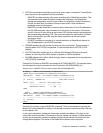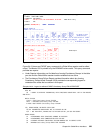
Chapter 24. Global Mirror interfaces 317
hex notation. In hex notation the third parameter refers to the channel connection address
(CCA) of the corresponding device.
24.5.4 Establish FlashCopy relationships
The next step is to create the FlashCopy relationship between the B volume and the C
volumes at the remote site; note in Figure 24-10 the particular attributes for FlashCopy
because it is being used in a Global Mirror environment.
Figure 24-10 ICKDSF - create FlashCopy relationship for Global Mirror
Depending on whether you connect to the remote site or to the local site, the FlashCopy
command is either directly issued to the remote storage disk subsystem or via an inband
command. The inband command is targeted to the local primary volume, and provides
addressing information for the FlashCopy source and target volumes at the remote site.
Example 24-25 shows an inband ICKDSF job example under the assumption that usually
there is no host connection from the local site to the remote storage disk subsystem, which
may reside on another continent.
Example 24-25 ICKDSF FlashCopy establish via an inband command
//* -------------------------------------------------------------- ***
//STEP01 EXEC PGM=ICKDSF
//SYSPRINT DD SYSOUT=*
//SYSIN DD *
FLASHCPY UNIT(7000) ESTABLISH -
SOURCEVOL(X'00' X'00' X'7800' 25941) -
TARGETVOL(X'01' X'00' 7900) -
CHANGERCD(YES) -
INHIBWRTS(YES) -
MODE(NOCOPY) -
TARGETCANCOMEONLINE(NO)
FC UNIT(7000) QUERY -
SRCVOL(X'00' X'00' X'7800' 25941
/*
Remote site
(secondary)
Master
Subordinate
LSS
LSS
LSS
LSS
LSS
LSS
Long distance
Global Copy
volume pairs
Local site
(primary)
Flashcopy target
Primary volumes Secondary volumes = Flashcopy source
Global Mirror
session paths
Change recording
Target write inhibited
Persistent
No background copy
Global Copy
paths
Global Copy
paths
Host


















